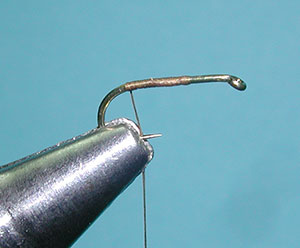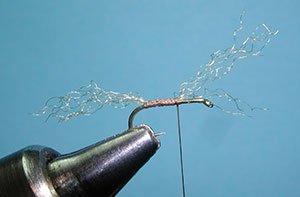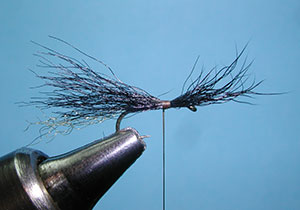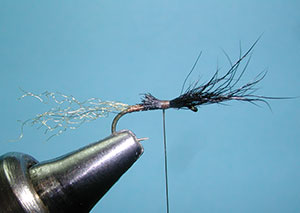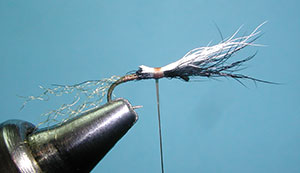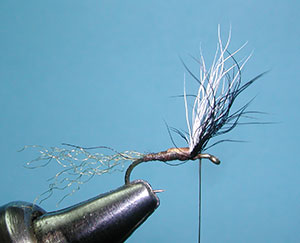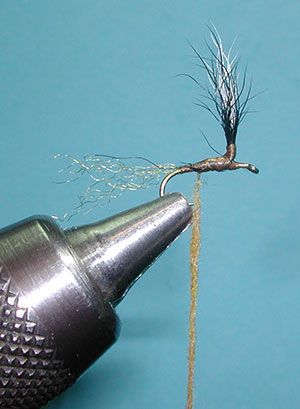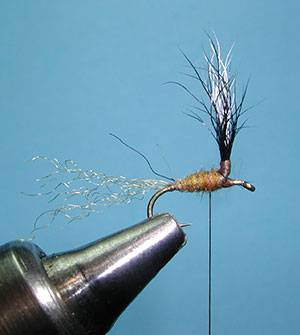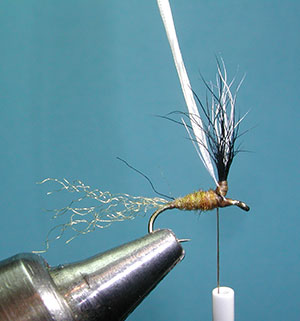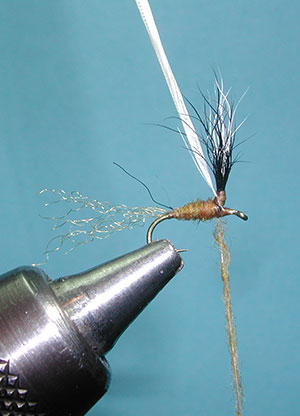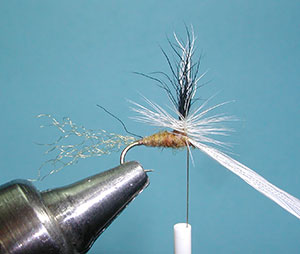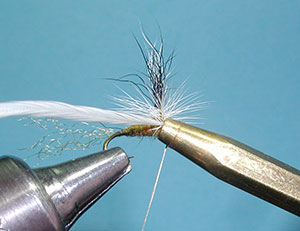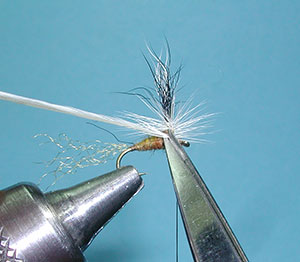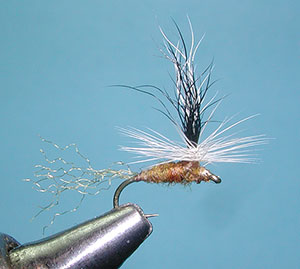Bivisible Dun – better visibility with two-tone
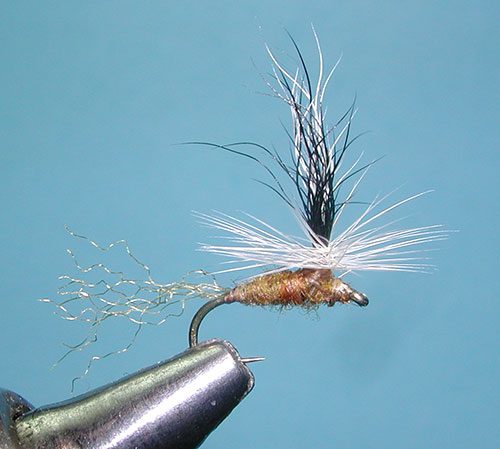
Bivisible Dun, Baetis
Tying Instructions
| Materials
to Order Material, click the link |
|
|---|---|
| Hook | TMC 100sp-bl #18-20 |
| Thread | Veevus Brown 10/0 |
| Body | Olive Brown Superfine Dubbing |
| Tail | Ginger Kinky Z-lon |
| Wingpost | White and Black Calf Tail |
| Hackle | Dun Hackle |
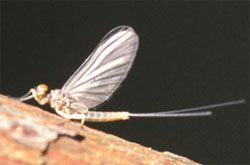

Ralph and Lisa Cutter
Bivisible Dun
The Bivisible Dun is a mayfly emerger pattern that was designed by Sierra fly fishing guide Ralph Cutter of Nevada City, CA. Ralph and Lisa Cutter owned California School of Fly Fishing which taught fly fishing for over 36 years. Ralph and Lisa closed the school in 2017 to retire. They are still active with Cal Trout, Trout Unlimited, Fly Fishers International, and United Anglers. The Bivisible Dun has no resemblance to the more renown Bivisible. The Bivisible is an attractor dry that is tied with two palmered hackle, the front hackle usually being a lighter color, often white.
Two colored Post
The Bivisible Dun is a Parachute Dun pattern with a two colored post and a trailing shuck similar to a sparkle dun. The only reason Ralph used the name Bivisible Dun is due to the two color post of white and black calf tail. Having this two-tone wing post can be a great advantage when the fly moves into and out of shadows. One or the other colors will stand out. The two-tone wingpost is also an advantage during a massive hatch where it distinguishes itself to the fly fisher from amongst the actual duns.
Ralph incorporated the characters of certain patterns and brought them together for this one. It tends to have the sillouette of a Sparkle Dun with it’s Z-lon tail and tapered dubbed body. The post and parachute characteristics come from a Parachute Dun. Calf Tail can be tricky since the kinky nature of the material makes it impossible to even the tips. AK Best focused on Turkey Flats for this reason. The color contrast of the black and white calf tail is distinct and a valuable aspect of this pattern. Try to keep the bulk of the material to a minimum by preening out the smaller underfur.
The Bivisible Dun works well on many baetis hatches. The Z-lon trailing shuck will help to submerge the pattern since it will absorb water while the parachute hackle keeps the upper portion of the fly within the surface film. Ralph has tied them to size 10 for Green Drakes and down to size 20 for small baetis. Many parachute dun patterns use a standard dry fly hook such as a TMC 100sp-bl, Ralph prefers the TMC 9300 which is a heavier wire and helps sink the rear portion of the Bivisible Dun.
Fishing the Bivisible Dun
When fishing this pattern look for signs of rises on the water surface where the trout are taking the emergers. The trout will often select an “observation post” that will be upstream of the the actual rise impression and it will be necessary to cast upstream from the rise so that the trout can actually observe the pattern prior to the take. Vince Marinaro illustrates this action within his book, Ring of the Rise, in 1995.
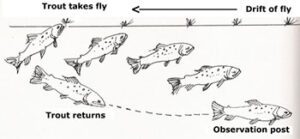
Observation
Placing the fly within the cone of sight of the trout is a function of depth of the observation post. If the trout is 3 feet below the surface, it can only see a cone of 2’8″ at the surface. If the trout is 12 inches below the surface it can only see a cone of 11″ at the surface. This illustrates the importance of presenting the fly within a narrow range that the trout can actually observe and react too.
Variations
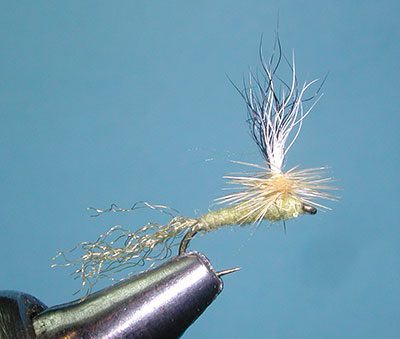
Bivisible Dun, PMD
| Hook | TMC 100sp-bl #16-18 |
| Thread | Veevus Light Cahill 10/0 |
| Body | Pale Morning Dun Superfine |
| Tail | Ginger Kinky Z-lon |
| Wingpost | White and Black Calf Tail |
| Hackle | Ginger Hackle |
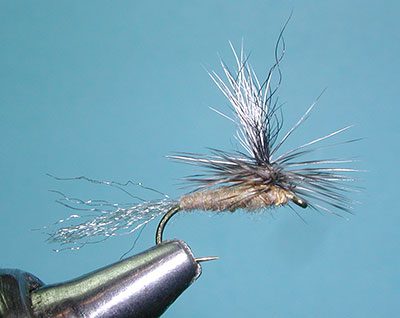
Bivisible Dun, Callibaetis
| Hook | TMC 100sp-bl #14-18 |
| Thread | Veevus Tan 12/0 |
| Body | Callibaetis Superfine |
| Tail | Dun Kinky Z-lon |
| Wingpost | White and Black Calf Tail |
| Hackle | Grizzly Hackle |
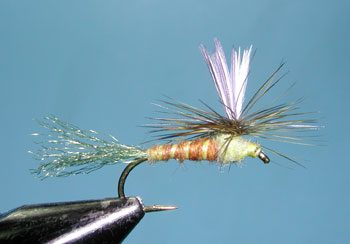
Bivisible Dun, Green Drake
| Hook | TMC 100sp-bl #10-12 |
| Thread | Danville Yellow 6/0 |
| Abdomen | Cinnamon Caddis Superfine |
| Thorax | Pale Yellow Superfine |
| Ribbing | Danville Yellow 6/0 |
| Tail | Brown Kinky Z-lon |
| Wingpost | White and Dark Dun Turkey Flat |
| Hackle | Olive Dyed Grizzly Hackle |

